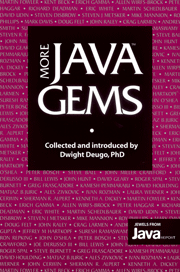Book contents
- Frontmatter
- Contents
- INTRODUCTION
- GETTING STARTED WITH JAVA
- MIGRATING TO JAVA
- TECHNIQUES 101
- MODELING AND PATTERNS
- JAVA IN A DISTRIBUTED WORLD
- THREADS
- USER INTERFACES
- SECURITY
- TESTING
- EFFECTIVE TEST STRATEGIES FOR ENTERPRISE-CRITICAL APPLICATIONS
- PUTTING JAVABEANS TO THE TEST
- TEST-INFECTED: PROGRAMMERS LOVE WRITING TESTS
- PERFORMANCE
- REALITY CHECK
- INDEX
PUTTING JAVABEANS TO THE TEST
Published online by Cambridge University Press: 06 July 2010
- Frontmatter
- Contents
- INTRODUCTION
- GETTING STARTED WITH JAVA
- MIGRATING TO JAVA
- TECHNIQUES 101
- MODELING AND PATTERNS
- JAVA IN A DISTRIBUTED WORLD
- THREADS
- USER INTERFACES
- SECURITY
- TESTING
- EFFECTIVE TEST STRATEGIES FOR ENTERPRISE-CRITICAL APPLICATIONS
- PUTTING JAVABEANS TO THE TEST
- TEST-INFECTED: PROGRAMMERS LOVE WRITING TESTS
- PERFORMANCE
- REALITY CHECK
- INDEX
Summary
Javabeans are reusable software components that are assembled using a visual assembly tool to create Java applets or applications. The JavaBean standard provides a software component architecture for Java that promises to deliver rapid application development (RAD) by enhancing reuse and increasing the abstraction level of software development, enabling even non-programmers to develop Java applets and applications. JavaBeans derive power because one can configure and connect beans to achieve sophisticated functionality without knowing all of the internal details of beans themselves.
In principle, a bean may be used by just knowing “what” it does without necessarily knowing “how” it works. For example, a loan calculator bean can calculate the principal and interest due on a loan. Generally, this is sufficient information to use the bean without having to know the details of the algorithm the bean uses. However, this requires some measure of trust on the part of the person using the bean. To draw again on the loan calculator bean example—if the configured loan calculator bean says we need to make a payment of $550 per month for the term of the loan, we need to trust that this result is correct without meticulously working through the beans implementation to ensure it calculates correctly. Clearly, without this trust the bean loses much of its power as a software component for reuse and RAD, and worse still, fuels the “not invented here” syndrome.
- Type
- Chapter
- Information
- More Java Gems , pp. 351 - 356Publisher: Cambridge University PressPrint publication year: 2000



